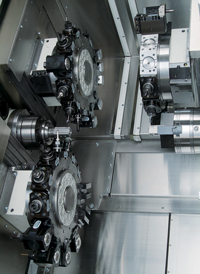With so much terminology in the marketplace when it comes to lathes with two spindles, the first step in the buying process often is to simply understand the subtle differences.
Subspindle, twin spindle, dual spindle, main spindle, and secondary spindle all are terms used to describe the spindle architecture inside a machine. Machine tool manufacturers will apply this terminology in different ways, depending partly on the component setup and partly on individual preference.
Main spindle. This is the main working spindle of the lathe.
Secondary spindle. Also sometimes called the pick-off spindle or back spindle, this spindle is located to the right of the main spindle and can be identical to or inferior to the main spindle.
Subspindle. When the word subspindle is used, it typically means that the spindle to the right is inferior to the spindle to the left. The inferiority comes in the form of less horsepower, a smaller chuck, and less through-bore capacity. In a subspindle-style machine, the two spindles usually face each other, allowing a transfer of some type to happen between the spindles. This enables the machine to process parts almost continuously.
Twin spindle. In a twin-spindle setup on a CNC lathe, both spindles usually are identical in specifications and capacities.
Dual spindle. Dual-spindle lathes typically are defined as having a main spindle and secondary spindle with identical chuck size and through-bore capacity, but with different horsepowers.
Two spindle. There are different types of two-spindle machines. In one style the spindles face each, and in the second style they do not. The second type requires either a manual or gantry-style loading system.
Two-spindle Work
Productivity, cost per part, back-working capability, and quality all can be positively affected by adding a turning center with a second spindle to your shop floor.
“Dual-spindle machines increase productivity by reducing part handling by automatically transferring parts from one chuck to another for secondary operations,” explained Milton Ramirez, product technical specialist - turning products for machine tool manufacturer Haas Automation.

When more tools and options are integrated, lower-volume, high-variety parts can be produced economically.
Also, different codes command the secondary spindle chuck to open, rotate, stop, and orient.
“The Haas control has a special code, called G14, that reverses or mirrors the complete program so a programmer does not have to worry about programming the secondary spindle differently than the main spindle,” said Ramirez. “This avoids the confusion of having to use so many different codes and numeric positioning values.”
Spindle Synchronization
New to Haas is the full synchronization option of both spindles for part-off and on-the-fly pass-off of parts. This can also be achieved while cutting with constant surface speed.
“The main and secondary spindles have matching chucks and ample horsepower for those demanding operations where torque and horsepower are a must,” said Ramirez.
Another company introducing spindle synchronization technology is Nakamura-Tome.
Its new spindle synchronization capability is for both turning and C-axis milling modes and enables manufacturers to reduce the acceleration time by more than half while both of the machine’s spindles are attached to a long part.
“Historically this work needed to be high production in nature, like automotive, but we are seeing significantly more sales in the aerospace, commercial, and medical fields,” said Elliott-Matsuura Canada Applications Engineer Kevin Smith.
Elliott-Matsuura is the Canadian distributor of Nakamura-Tome equipment.
“Today’s two-spindle lathes can be very simple to automate, especially if they have both multiple turrets and spindles. A twin-spindle lathe can be automated quite simply by adding a bar loader and using the second spindle to basically complete the part,” said Smith.
A parts-removal system of some type is required to remove the finished product from the second spindle to allow for unattended machining. Also, if the part is larger than the maximum barstock size, then a gantry loader can be added to load and unload the second spindles in the machine envelope.
Multiple-turret Lathes
Adding turrets inside the work envelope enables more flexible machining. When more tools and options are integrated, lower-volume, high-variety parts can be produced economically.
“We sell more multi-turret Nakamura WT machines than we do single-turret machines,” said Smith. “This is based on customers seeing the benefit of a solid and technically advanced two-spindle, multi-turret lathe that reduces cycle time and changeover time.”
No matter the type of machine or the terminology used, a distinct competitive advantage can be gained from having more spindles working inside the machine.
“There is always a cost savings to having a second spindle in a machine,” said Smith. “If you manually handle a part less, you inevitably will lower the cost of the finished product and increase profits.”

